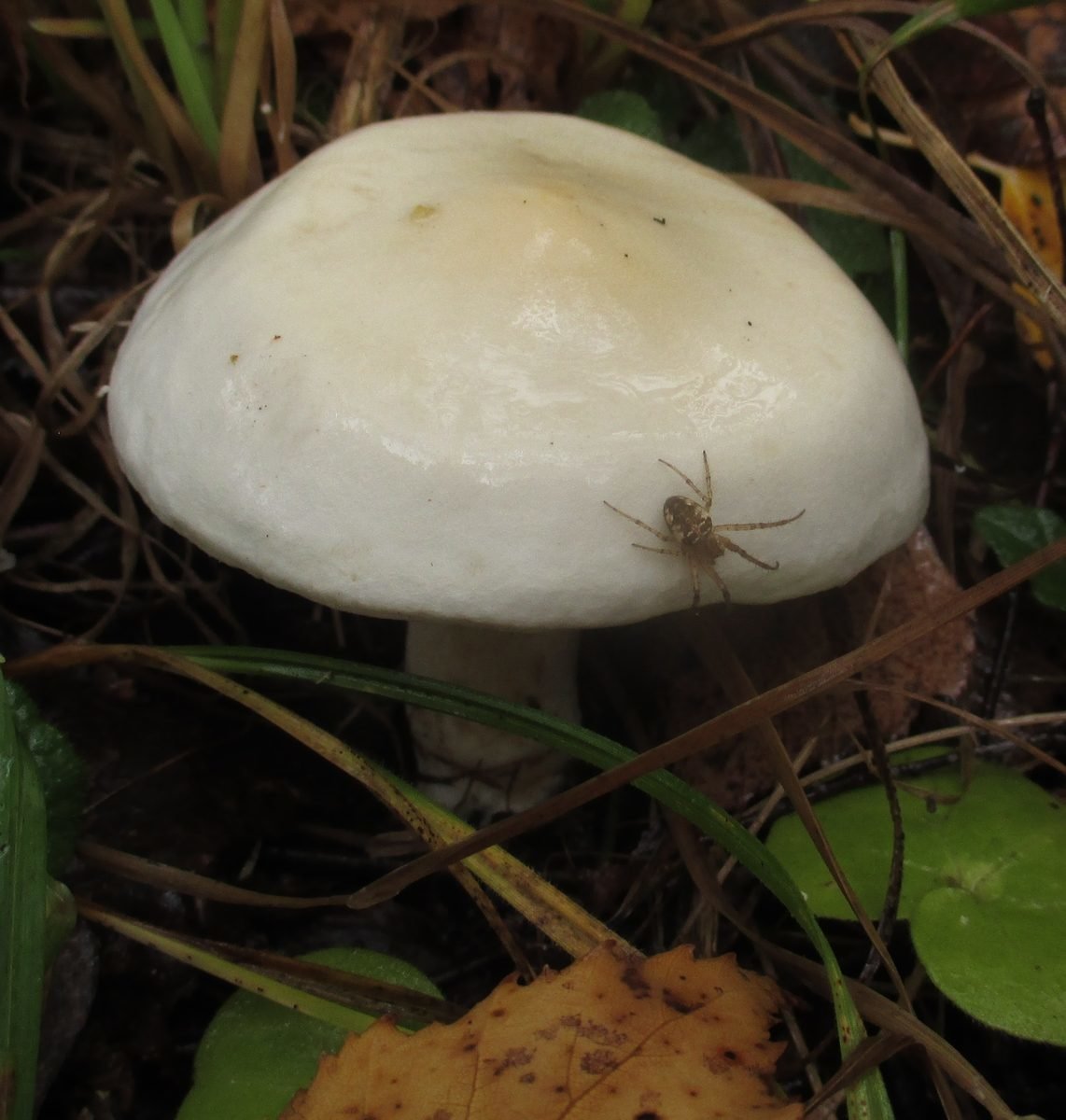Row often-plate (Tricholoma stiparophyllum)
- Divisioun: Basidiomycota (Basidiomycetes)
- Ënnerdeelung: Agaricomycotina (Agaricomycetes)
- Klasse: Agaricomycetes (Agaricomycetes)
- Ënnerklass: Agaricomycetidae (Agaricomycetes)
- Uerdnung: Agaricales (Agaric oder Lamellar)
- Famill: Tricholomataceae (Tricholomovye oder Ryadovkovye)
- Gattung: Tricholoma (Tricholoma oder Ryadovka)
- Typ: Tricholoma stiparophyllum
:

The specific epithet of Tricholoma stiparophyllum (N. Lund) P. Karst., Meddn Soc. Fauna Flora fenn. 5:42 (1879) comes from a combination of the words stipo, which means “densely gather, crowd”, and phyllus (referring to leaves, in the mycological sense – to the plates). Hence the -language epithet – often-plate.
Kapp 4-14 cm in diameter, convex or bell-shaped when young, flat-convex or prostrate at age, may have a rather low tubercle, smooth or slightly velvety, in some cases it may crack. The edge of the cap is bent for a long time, then straight, in rare cases, in old age, turned upwards, often wavy, often ribbed. The hat is painted in light, white, whitish, fawn, creamy colors. The cap in the center is often darker fawn, and dark spots and / or stains of fawn or ocher shades are also often observed.
Pulp dense, from white to fawn.
Geroch pronounced, unpleasant, described in various sources as chemical, as the smell of coal (coke oven) gas, the smell of stale food waste or the smell of dust. The latter seems to me the most accurate hit.
Probéiert unpleasant, with a musty or rancid floury taste, slightly spicy.
Records adherent to notched, medium width, medium frequent, white or cream, aged or on lesions with brown spots.

Spore Pudder wäiss.
Sträitfäll hyalin am Waasser a KOH, glat, meeschtens ellipsoid, 4.3-8.0 x 3.1-5.6 µm, Q 1.1-1.9, Qe 1.35-1.55
Been 5-12 cm long, 8-25 mm in diameter, white, pale-yellowish, in the lower part often with yellow-brown spots or stains, cylindrical or slightly expanded from below, often rooting, covered in this place with white mycelium of a felt type, in the rest in some places smooth, or with a slight frost-like coating, often finely scaly in the lower part.
The common-leaved rowweed grows from August to November, is associated with birch, prefers sandy and peaty soils, but is also found on other types of soils, is widespread and very widespread, often forms rather large clusters in the form of circles, arcs, straight sections, etc.
- Row white (Tricholoma album). You could say it’s a doppelgänger. It differs, first of all, in living together with oak. The edge of the cap in this species is not ribbed, and, on average, the white row has fruiting bodies of a more accurate and even shape. In the smell of this species there are sweetish honey notes on the general less unpleasant background. However, if a mushroom is found where both birch and oak are nearby, it is most often extremely difficult to make a decision about the species, and not always possible.
- Reihen sinn feid (Tricholoma lascivum). This species is also often confused with the often-plate row, and even more so with the white one. The species grows with beech on soft humus (mulle) soils, has a strong bitter and pungent aftertaste, and has a gray-yellow color that is not characteristic of the species in question.
- Stinky rowweed (Tricholoma inamoenum). It has rare plates, fruiting bodies of a noticeably smaller and frailer appearance, lives with spruce and fir.
- Ryadovki Tricholoma sulphurescens, Tricholoma boreosulphurescens. They are distinguished by yellowing of the fruiting bodies at the points of contact, despite the fact that they smell just as disgusting. If the first of them grows together with beech or oak, then the second, like the often-lamellar, is associated with birch.
- Humpback Row (Tricholoma umbonatum). It has a pronounced radial-fibrous structure of the cap, especially in the center, has olive or greenish hues in the fibrous part, its smell is weak or floury.
- D'Rei ass wäisseg (Tricholoma albidum). This species has a not very clear status, like, today, it is a subspecies of the silver-gray row – Trichioloma argyraceum var. albidum. It differs by the radial texture of the cap, similar to a pigeon’s row or with silver rows, it is distinguished by yellowing at the touch points or yellow spots for no apparent reason, and a mild floury smell.
- Pigeon row (Tricholoma columbetta). It has a pronounced radial-fibrous silky-shiny structure of the cap, in which it immediately differs. Its smell is weak or farinaceous, pleasant.
Rows are often considered inedible due to their unpleasant odor and taste.









